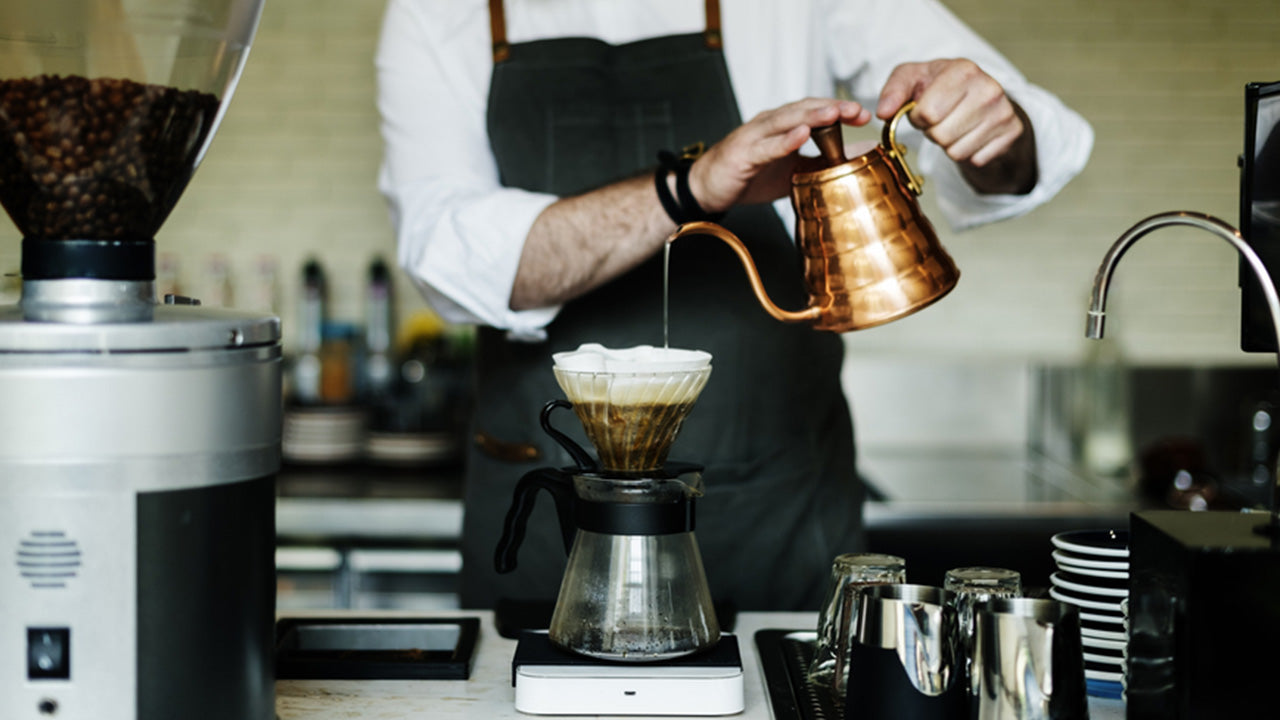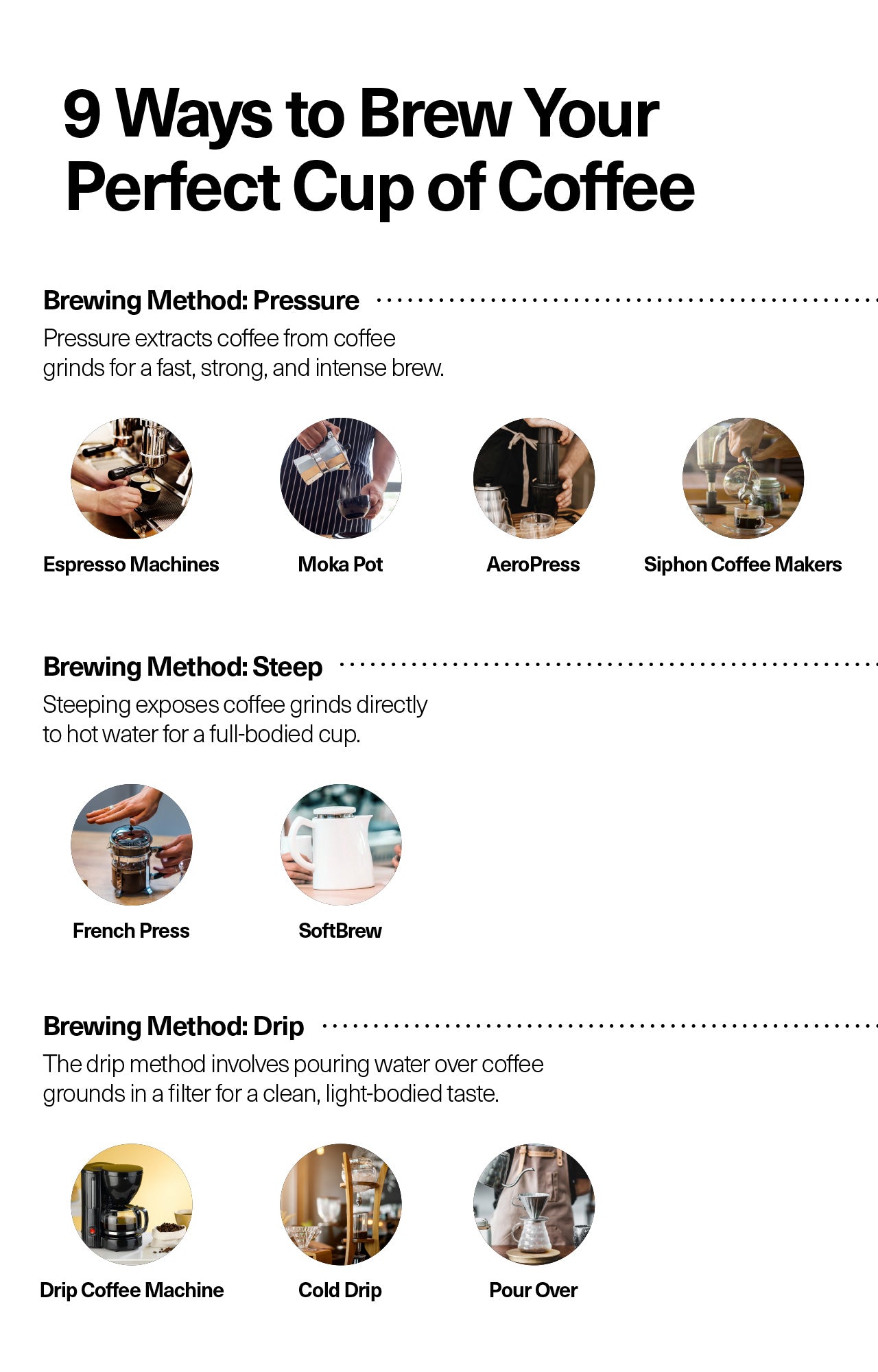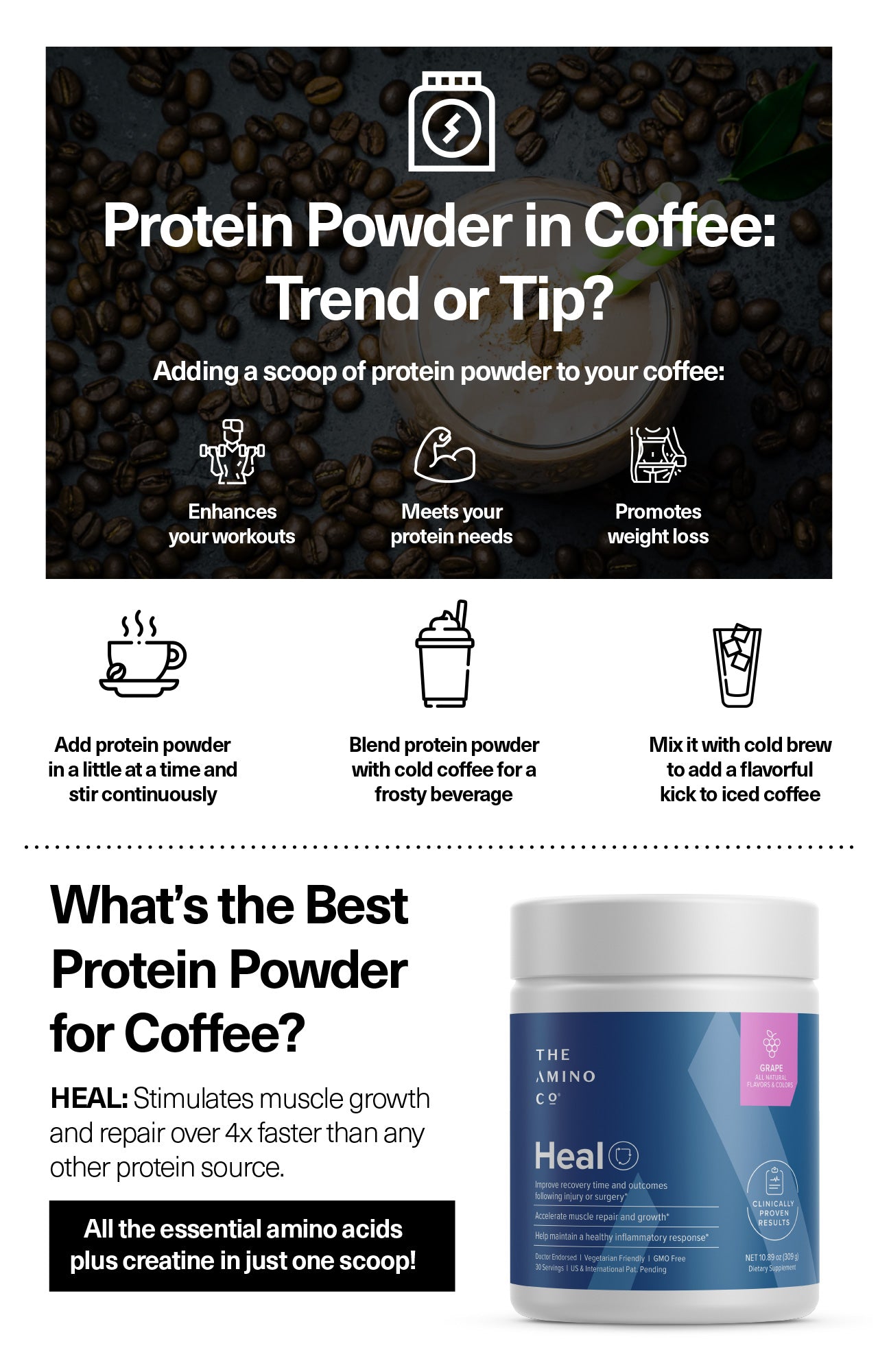9 Ways to Brew Coffee (and Get Your Protein Too)
 By: by Amino Science
By: by Amino Science

Whether you’re practicing social distancing and going on fewer coffee shop runs or you just want to master your artisanal coffee-making skills, you’ve come to the right place. We’re breaking down nine of the most popular ways to brew coffee to help you figure out your preference and make the perfect cup at home.
You know what makes a cup of coffee even better? A scoop of protein for steadier energy, stronger workouts, and weight loss to boot. So without further ado, here’s how to make your perfect cup of coffee and add in protein for good measure.
Brewing Method: Pressure
Coffee brewing via pressure is the method behind espresso machines, the Moka Pot, the AeroPress, and siphon coffee makers. It’s simple: coffee is extracted from coffee grinds using pressure. It’s fast and delivers a strong and intense brew.
Espresso Machines
Espresso makers have been delivering thick and creamy espressos since 1901, although they’ve evolved with many bells and whistles that become more ornate the higher up the price spectrum you go...as much as $20,000 or more!
Don’t worry; the basics are the same in low- and high-end models. All you really need from an espresso machine are the filter (called the "porta-filter"), the boiler or heat exchanger, the reservoir, and the pump, which push the pressurized water through a puck of coffee grinds and out as a shot of espresso.
Espresso machines are available as fully automatic for those who want no part of the espresso-making process beyond pressing start, semi-automatic, portable, or manual lever for espresso connoisseurs who enjoy playing barista.
You can count on a rich, sharp, highly concentrated espresso that can easily be converted into an Americano with hot water or a latte with frothy milk. The machines take less than 3 minutes to warm up and just 20-30 seconds to shoot out your espresso shot.
Pro tip: Espresso machines do best with fine coffee grinds. Pinch the grinds to make sure they’re perfect. If it clumps, you’re golden. If it doesn’t clump, the grinds are too coarse, and if it clumps too much, the grinds are too fine...try again!
This is for you if: You love the taste of a creamy espresso, like the ease of an automatic brewing method, and get impatient with brew methods that take more than 3 minutes.
Moka Pot
Invented in Italy in 1933, the Moka Pot is a preferred coffee brewing method in Europe and Latin America. It brews your coffee on the stovetop using a 3-chamber process: first, the water in the bottom chamber heats to a boil; then, pressure from steam forces the water up through the coffee grounds and into the top chamber. Voila! A strong and bitter-sweet blend that is more robust than drip coffee but not as high quality as espresso devotees might like.
The pros of the Moka Pot include ease of use, the fast factor for busy mornings, and multiple cups if you’re caffeinating for family and friends.
Pro tip: You’ll want to try for a grind somewhere between coarse and fine. The good news is that the Moka Pot makes it easy to experiment. If you end up with a cup of coffee that’s weak and watery, try for a finer grind, and if your coffee ends up too bitter, then lean toward coarseness next time.
This is for you if: You want ease, convenience, and portability alongside a strong cup of coffee that can be adjusted according to your favorite flavor profile and able to caffeinate more than one.
AeroPress
The AeroPress came onto (and stole the scene) in 2005. It’s well loved for several reasons.
- It’s small and portable for travel
- It’s easy to clean
- It delivers a bold, espresso-like taste
- It keeps coffee clean and sediment free (don’t use a metal filter)
- It’s versatile: can make regular coffee, cold brew, or an espresso replica (almost)
You might want to pass on AeroPress coffee, however, if you’d rather not contribute to waste (it takes a lot of paper filters), and if you want to brew more than 2 cups of coffee at a time.
Pro tip: AeroPress recommends fine drip or espresso grind, noting that espresso grind is for the patient and skilled. If all you have on hand is preground drip coffee you can use that too, but use a little more than usual and be sure to steep for longer to ensure a strong cup of joe.
This is for you if: You travel often, don’t want to compromise on taste, and want as much versatility as possible in a portable coffee maker.
Siphon
Siphon coffee makers satisfy the mad scientist in us all. Also known as the vac pot or syphon, this cool but complicated coffee maker was invented in Europe in the early 1800s, and it continues to impress, especially at parties.
The machine uses vacuum pressure, a live flame, and two glass “balloons” to deliver a strong and robust cup of coffee. It’s equal parts gorgeous and functional. But it’s also quite involved and can take a good 10 minutes of brew time.
Fill the first chamber with water, heat the bottom chamber and wait as vapor pressure drives the water into the upper chamber to be mixed with coffee grounds. Once it’s all mixed up, the water passes through a filter as it’s pulled back into the bottom chamber where it awaits you.
Pro tip: Coffee grounds should be medium-fine to medium-coarse for this brew method, and you’ll want to soak your filter in warm water for at least 5 minutes before you’re ready to brew.
This is for you if: You like a clean, flavorful coffee and enjoy the magic of brewing your perfect cup of coffee.
Brewing Method: Steep
Perhaps the oldest and simplest way to make coffee, steeping is the method behind the popular French Press and newer SoftBrew.
Steeping is as easy as exposing coffee grinds directly to hot water, and then dumping out the grinds and keeping the water when steep time is up. There is an art to it, however: don’t steep enough and you’ll get a watered-down and weak cup of coffee; steep too much and you’re likely to have a bitter, inedible brew.
French Press
You can use your French press to make coffee or tea as people have been doing since its invention in 1929. Simply fill the carafe with water, steep for 5-10 minutes according to taste, press slowly down on the plunger to separate the grinds from the liquid, pour and enjoy!
Yes, it takes longer to press your cup of coffee, but the flavor is full-bodied and there’s all the more time to enjoy that indulgent coffee aroma.
Pro tip: Opt for a coarser coffee grind for French press coffee because if it’s too fine the coffee grounds will stick to the filter and remain in your coffee. It’s typically a good ideal to leave a swig or two of coffee in your mug, as there tends to be remaining sediment at the bottom. Unless, of course, gritty coffee is your thing.
This is for you if: You like coffee that’s easy to make, you don’t want to spend a fortune on a coffee maker, and you appreciate the robust, natural flavor of coffee. Portability is a plus, although beware of that delicate glass!
SoftBrew
SoftBrew quickly became one of the best ways to brew coffee when it entered the marketplace in 2010. It looks and acts like a teapot, and is equally adorable.
Like the French press, brew time varies between 5-10 minutes, but it’s easier to operate. Fill the stainless steel filter with coffee grounds, add hot water, and let it steep. The result: A distinct, rich, full-body brew without any gritty grinds left over.
Pro tip: The filter is designed with hundreds of thousands of holes that are so small not even super fine coffee grinds can get through so fill it up as desired.
This is for you if: You like your coffee clean with depth but prefer a hands-off approach. Let’s just say you’re not trying to win any awards as a coffee creative.
Brewing Method: Drip
This category includes cold brewing, drip machines, and the classic pour over. The brewing process involves pouring water over coffee grounds in a filter. The water passes through the filter and the grounds, resulting in a clean, thin, light-bodied taste.
Drip Coffee Maker
The drip coffee machine replaced the percolator in the 1970s as everyone’s favorite convenience. Set your dripper to a schedule and awake to freshly brewed coffee.
Pro tip: Silence the naysayers who say drip coffee is low quality by purchasing high-quality, whole coffee beans and grinding them right before you’re ready to brew.
This is for you if: There are multiple coffee drinkers in your house, your mornings are busy, and you need to automate as much as possible.
Cold Brew and Drip
There’s cold brew and there’s cold drip. Cold brew mixes coffee grounds and cold water and leaves it to brew for 18-24 hours. It’s then separated from the coffee grounds and poured over ice.
Cold drip keeps the cold water and coffee grounds separate as a drip tower allows the water to drip over the ground coffee in a timed fashion...one that takes 3.5 to 12 hours to complete. Cold drip is also served over ice but as an espresso-sized shot.
Both coffee concentrates result in a strong taste without the bitterness unique to coffee for a more smooth and less acidic flavor profile. Cold brew coffee enthusiasts swear it gives you stable energy without a crash later in the day.
Pro tip: Use medium to coarse grinds, as fine grinds end up dirtying the coffee, and cold brew is all about clean.
This is for you if: You live in a warm climate, are willing to put in the leg work and patiently wait for the perfect brew, and you prefer to take your coffee without the bitterness.
Pour Over
When it comes to brewing coffee, the pour over doesn’t get the respect it deserves. It’s one of the best ways to brew coffee when it comes to matching you with your desired flavor and aroma.
It’s super simple and makes good coffee in under 5 minutes. Just pour hot water over a cylindrical coffee filter filled with ground coffee beans. Get fancy with a manual pour-over style glass coffee brewer like the Chemex, Hario V60, Kalita Wave, or the Melitta Ready Set Joe dripper. You get to pick the grounds and the intensity of the brew.
Pro tip: Grind size can vary from medium-fine to medium-coarse but must be consistent, so if the pour over is your method of choice then consider investing in a coffee grinder that delivers the beans, so to speak.
This is for you if: You like to be in charge of your coffee’s taste and enjoy experimenting to bring out the beans’ best flavor.

Why You Should Add Protein Powder to Coffee
You’ve finally brewed the perfect coffee, why should you add protein powder to your cup? Beyond giving it an extra boost of flavor, the extra protein can help coffee lovers like you reach their wellness goals.
Protein Improves Workouts
There’s a reason why caffeine shows up in sports drinks. It enhances muscle contractions and keeps you from fatiguing too early. Caffeine performs even better when it’s matched with protein, which is made up of the building blocks of your muscle tissue. Protein helps your muscles recover from exercise and grow bigger and stronger. But don’t just take our word for it. Check out this meta-analysis published June 2020 in the Journal of Nutrition, and this review published March 2018 in the British Journal of Sports Medicine.
Protein Protects Against Deficiency
Using the DRI (Dietary Reference Intake) as a guide (0.36 grams of protein per pound), the average sedentary man requires 56 grams of protein each day and the average sedentary woman requires 46 grams of protein daily. Those are just the minimums. Add exercise, aging needs, health conditions, surgery, illness, injury, or stress to the mix and your protein needs shoot drastically up.
Starting your morning or fueling your afternoon with a cup of coffee enhanced by a scoop of protein powder ensures you’re protecting against any protein intake gaps and giving your body and brain the amino acids it needs to repair, regenerate, and keep functioning on all cylinders.
Protein Promotes Weight Loss
Protein promotes weight loss in a few ways. First, it boosts your metabolism. The body has to work harder breaking down protein than it does breaking down fats and carbohydrates.
Second, protein helps you keep your muscles while you lose fat on a weight-loss program.
And third, protein lowers levels of hunger hormones, so you feel fuller for longer. Add it to your cup of coffee in the morning and you may find yourself snacking less throughout the day.
And what do we know about caffeine and weight loss? It, too, is boosting your metabolism, decreasing hunger hormones, and increasing production of the hormones that keep you feeling full.
How to Add Protein Powder to Coffee
It’s as easy as adding in a scoop of protein powder and stirring, right?
Well...sort of. Depending on the type of protein powder you’re using. Some are prone to clumping when combined with hot liquids such as coffee. That doesn’t entirely rule them out though.
To prevent clumping when adding protein powder to hot coffee, add in a little at a time and stir as you go.
You can also blend up your protein coffee to keep it from clumping, but if blending while hot be sure to remove the plastic lid so it doesn’t crack.
Protein powder added to cold coffee, like your cold brew, tends to mix smoother and also lends itself to smoothie blends.

The Best Type of Protein Powder for Your Coffee
There are many types of protein powders on the market—collagen, whey, and pea proteins, to name a few—but there’s only one that’s been proven to stimulate muscle growth and repair over 4x faster per gram than any other protein source.
It is an essential amino acid blend of eight EAAs designed specifically for triggering muscle recovery and repair. This is the same formula that was developed for NASA astronauts, and has been shown in clinical trials to actually increase muscle mass even during periods of inactivity. Essential amino acids are absorbed very rapidly by the body, and whey protein is digested slowly, which is why we added whey protein. Your body gets the rapid absorption from the EAA mixture, and then has a prolonged effect due to the slower digestion time of whey. Also, there is evidence that including a small amount of nonessential amino acids increases the effectiveness of the EAAs, and the nonessentials in whey protein provide this.
We call it Heal, and when added to your coffee it can help improve muscle recovery and performance while promoting a healthy inflammation response. It has also been clinically proven to accelerate recovery from injuries and surgeries. And it comes in vanilla and chocolate flavors, giving your coffee taste a decadent kick.
To learn more about our essential amino acid-based protein powder and how it can keep you healthy and strong, visit our product page here.
And let us know your preferred method of coffee brewing in the comments below!

Up to 25% off Amino
Shop NowTAGS: food
Join the Community
Comments (0)
Most Craveable Recipes




 833-264-6620
833-264-6620



















